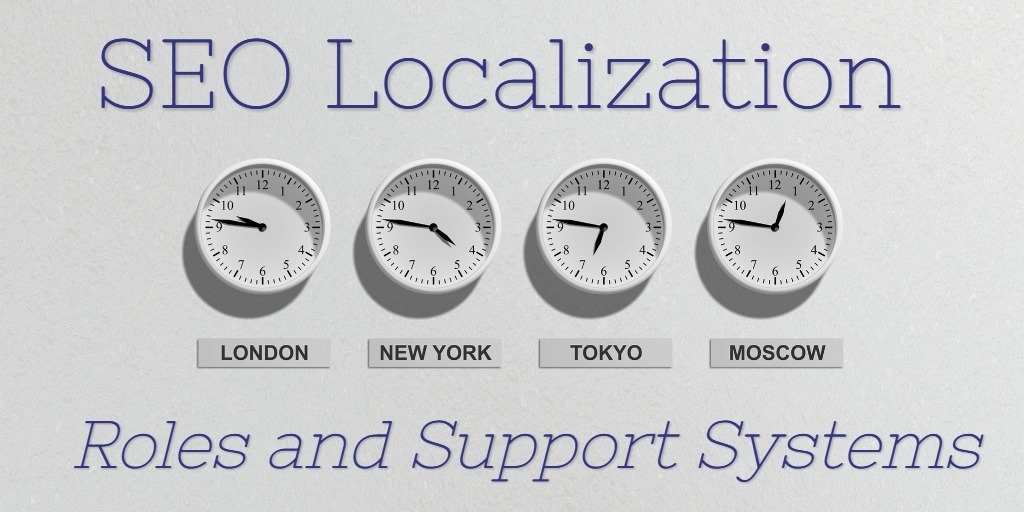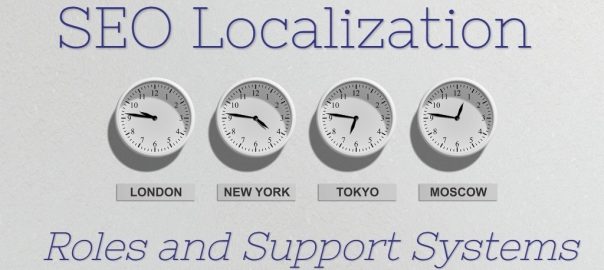
Everything starts with planning and setting expectations and goals. I covered initial phase of website Localization in How to Plan Website Globalization & Localization post. By now, you should know your organization’s globalization mission and have a plan to support it. Armed with goals to support the mission and metrics to benchmark against competitors, you will measure your team’s contribution to the success of the company.
Can you do it all alone? Perhaps, you can. You will play many roles in order to provide services and localized products. What would be the responsibilities of each role?
Main Functions And Roles
There are several universal functions that need to be filled no matter how advanced your localization effort is. You need specialists to oversee strategy, user experience, content, and technology. The team can start with one person who will be responsible for tactical execution as well as working with regions and global stakeholders. There would be little strategy at this stage – mostly operational requirements to perform translations of the business critical content. An important role for the Localization lead would be to represent the regions in the corporate office and communicate corporate vision out to the regions.
Project / Program Management function is critical to your success. It is important to have a seasoned project manager in this role, who will be working with multiple business teams, stakeholders, and groups. I suggest you do not outsource this function and keep them working out of the corporate office.
The Localization Project Manager will prepare projects for translation, assemble all content types for hand off to a translation vendor, manage and enforce timeline, line up resources to receive and process completed translations. They will maintain glossaries and style guides. They will be responsible for training and knowledge documentation. Project manager will often take on operational responsibilities, like developing and implementing appropriate metrics or working with teams to implement process improvements.
Translation function usually is filled in house or outsourced to an agency: a Language Service Provider (LSP). If you are going with an agency solution, make sure your technology works with their technology seamlessly and with as much automation as possible. If you are outsourcing translation, technology team should handle the integration between your CMS and translation provider technology.
If you are outsourcing anything to a vendor, you will need to fill Vendor Management role. A vendor manager will handle vendor selection process, vendor relationships, quality of translation, budget, etc. Prepare to be busy. They also resolve any vendor issues, manage budgets and POs. They evaluate vendors and work with Procurement to manage costs.
Publishing function falls under content. This would be a person who will publish translated content on the localized site. At first, when you have one or two languages, it will be easy. It could be the person translating the content. It is possible that this role will grow into linguistic specialist who will be responsible for translation quality and accuracy. Of course, this person would need to be a native speaker of the language and be a subject matter expert.
As you grow, you will need several people, possibly speakers of the website language, who will perform publishing tasks and will validate the translations.
Localization Developer is important for internationalization of your CMS. This includes developing globalization software architecture, automation tools, recommend and implement translation connectors and localization plug-ins, managing technology vendors.
[
Your content needs to automatically convert to the localeClick To Tweet
Your content needs to automatically convert to the locale. For example, one and a half is 1.5 in the US, China, Mexico and 1,5 in Russia, Germany, Brazil. If your event is on January 3rd , communicate it as 1/3/2017 to the American audience, 3/1/2017 to European audience. Does 3K mean 3 thousand or 3 kilos?
Do you want to make changes by hand to every date that appears on your pages? I didn’t think so. Localization developer prepares your CMS for localization so numbers, dates, currencies, addresses, phones, measuring units, etc. are displayed correctly based on the language of the site. They also make sure that your website components are designed so they can account for 30% longer sentences in German and Chinese and the line breaks in Japanese language do not break the esthetics of the website design, spacing and formatting.
Localization Quality Assurance role is essential for testing and validating the quality of the site. Linguistic QA will watch out for translation accuracy, compliance, untranslated text. Functional QA addresses space issues, improperly mirrored UI (right-to-left languages), incorrect encoding, etc. In-house linguistic reviewers could report into QA role to ensure quick turnaround and high levels of quality.
You will need Translation Management System solution (TMS), where your translations will be kept for reference, so only new content is translated every time you submit your pages. There are stand-alone systems or integrated with other translation services. If you engaged with a large LSP, they often have their own TMS. If you are using several LSPs and multiple translation solutions, it is advisable to have a TMS that the whole company is using so you can leverage translation memory to keep consistency up and the cost down.
Final Thoughts
Centralized, distributed, or hybrid organizational model, every employee needs to understand digital marketing, your CMS system, and SEO. There has to be a localization program manager in each region who is responsible for regional localization, even if it is not their full time job. Otherwise, you will be drowning in website issues, unable hand-off responsibilities to the regional team.
Start The Process By Asking Questions
Do You need to hire people? For what roles? How many? What would the reporting structure look like? The more developed localization function in your company, the higher rate of its international growth, the more people you will need globally to support it. Funding most likely will come from the department that is driving the requirements and pushing for localization function.
If you already have a team, it is time to decide if you need to re-train them, change their job descriptions, re-assign, etc. If you are not the one who will be building up globalization team in your company, hire an experienced manager and put them in charge of translation and localization.
And on a higher level, how would your localization team fit into the organizational chart of the company? Do you need to centralize localization function or keep it local? Perhaps, a hybrid system works best. How would you measure the success and calculate localization contributions to the company revenue?
In my next post, I will talk about growing a globalization team, scaling, adjusting your staffing levels to growing demands of a business expanding internationally.
The post SEO Localization Roles and Support Systems appeared first on Search Engine People Blog.
SEO Localization Roles and Support Systems
(65)
Report Post




